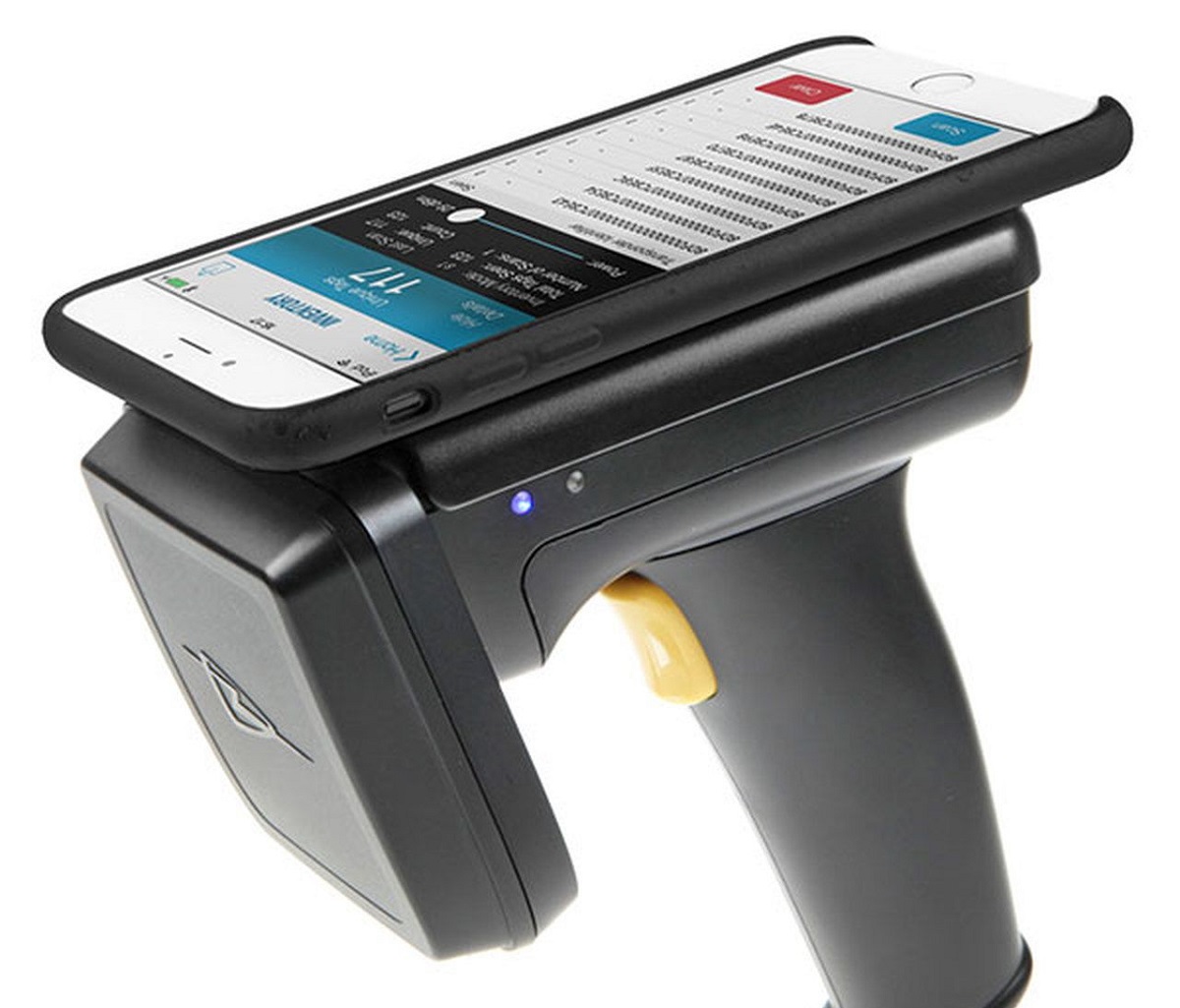Introduction
Radio Frequency Identification (RFID) technology has revolutionized the way supply chains operate, offering a myriad of benefits to businesses worldwide. As a system that uses electromagnetic fields to automatically identify and track objects, RFID has proven to be a valuable tool in improving supply chain management.
In recent years, RFID technology has gained significant traction in various industries, including retail, manufacturing, logistics, and healthcare. Its ability to provide real-time visibility, streamline processes, and enhance inventory management has made it a sought-after solution for companies looking to optimize their supply chain operations.
With RFID technology, businesses can effectively monitor and track the movement of goods throughout the supply chain, from the point of production to the point of delivery. This level of visibility provides valuable insights into inventory levels, location, and condition, enabling businesses to make informed decisions and respond to changing customer demands quickly.
In this article, we will explore the impact of RFID technology on the supply chain and delve into the various benefits it offers. We will also discuss the challenges and limitations that businesses may face when implementing RFID systems. By understanding the potential advantages and drawbacks of RFID technology, companies can make informed decisions about integrating this technology into their supply chain management processes.
What is RFID?
RFID, or Radio Frequency Identification, is a technology that uses electromagnetic fields to automatically identify and track objects. It consists of three key components: RFID tags, RFID readers, and a backend system.
RFID tags are small electronic devices that contain a unique identifier and can be attached to various items such as products, pallets, or containers. These tags are equipped with an antenna that allows them to transmit and receive radio signals.
RFID readers, also known as interrogators, are devices that emit radio signals and capture the responses from nearby RFID tags. These readers can be handheld or installed in fixed locations, such as entry/exit points in a warehouse or distribution center.
The backend system is responsible for processing the data collected by the RFID readers. It includes the necessary software and hardware infrastructure to manage and analyze the information transmitted by the RFID tags.
When an RFID tag comes into the range of an RFID reader, it receives the radio signal emitted by the reader and responds with its unique identifier. The reader captures this response and sends it to the backend system, where the information is recorded and analyzed.
Unlike barcode technology, which requires line-of-sight scanning, RFID operates using radio waves. This means that multiple RFID tags can be read simultaneously, even if they are hidden or not directly visible to the reader. This capability makes RFID a powerful tool for inventory management and supply chain operations.
RFID technology comes in various forms, including passive RFID, active RFID, and semi-passive RFID. Passive RFID tags do not have an internal power source and rely solely on the energy emitted by the RFID reader to operate. Active RFID tags, on the other hand, have their power source and can transmit signals independently. Semi-passive RFID tags combine elements of both passive and active technology.
In the next section, we will explore how RFID technology works and its applications in supply chain management.
How does RFID work?
RFID technology operates through a process called Radio Frequency Identification, which involves the use of electromagnetic fields to identify and track objects. Understanding how RFID works is essential to comprehend its applications in supply chain management.
RFID operates with three main components: RFID tags, RFID readers, and a backend system. Let’s take a closer look at each of these components:
- RFID Tags: These small electronic devices are affixed to objects, such as products, pallets, or containers, and contain a unique identifier. RFID tags can come in different forms, including passive, active, or semi-passive. Passive RFID tags do not have their own power source and rely on the energy emitted by RFID readers to operate. Active RFID tags have their own power source and can transmit signals independently. Semi-passive RFID tags combine elements of both passive and active technology.
- RFID Readers: These devices emit radio signals and capture the responses from nearby RFID tags. RFID readers can be handheld or installed in fixed locations. When an RFID tag enters the range of a reader, it receives the radio signal emitted by the reader and responds with its unique identifier. The reader then captures this response and sends it to the backend system for processing.
- Backend System: This system consists of software and hardware infrastructure that manages and analyzes the data collected by the RFID readers. It records and stores information transmitted by the RFID tags, allowing businesses to access real-time data about their inventory and supply chain operations.
When an RFID tag comes in proximity to an RFID reader, the tag’s antenna receives the radio signal emitted by the reader and generates a small electrical current. This current powers the RFID tag, allowing it to transmit its unique identifier back to the reader. The reader captures this response and sends it to the backend system, where the data is processed and stored.
One of the key advantages of RFID technology is its ability to read multiple tags simultaneously. Unlike barcodes, which require line-of-sight scanning, RFID readers can capture data from multiple tags in a single scan, enabling efficient and accurate inventory management.
Overall, RFID technology provides businesses with a reliable and automated method of tracking and identifying objects in their supply chain. In the following sections, we will delve into the benefits that RFID offers to supply chain management.
Benefits of using RFID in the supply chain
The implementation of RFID technology in the supply chain brings numerous advantages to businesses across various industries. Let’s explore some of the key benefits of using RFID:
- Improved inventory management: RFID enables businesses to have real-time visibility into their inventory levels. With RFID tags attached to products or assets, companies can accurately track and monitor their stock, reducing the risk of stockouts and overstocking. This level of visibility allows for better demand forecasting, efficient stock replenishment, and optimized inventory turnover.
- Enhanced visibility and real-time tracking: RFID technology provides real-time tracking capabilities, enabling businesses to monitor the movement of goods throughout the supply chain. From the point of production to the point of delivery, RFID tags can be scanned at various checkpoints, providing valuable insights into the location, status, and condition of the items. This visibility allows for improved traceability, reduced delivery times, and enhanced customer satisfaction.
- Increased efficiency and accuracy in order fulfillment: With RFID, order fulfillment processes can be streamlined and automated. RFID tags can be used to verify the accuracy of picked items, reducing picking errors and improving order accuracy. The automated nature of RFID technology saves time and minimizes manual labor, allowing employees to focus on more value-added tasks.
- Streamlined supply chain processes: RFID technology enables the automation of various supply chain processes, such as receiving, put-away, picking, and shipping. By eliminating manual data entry and reducing human error, RFID helps streamline operations, increase productivity, and reduce operational costs.
- Decreased labor costs and improved productivity: Automating data collection and inventory management with RFID reduces the need for manual labor and repetitive tasks. This frees up employees’ time, allowing them to focus on higher-value activities, such as customer service or strategic decision-making. The reduction in labor costs and the increase in overall productivity can result in significant cost savings for businesses.
- Reduced risk of counterfeit products and theft: RFID tags can be used to ensure product authenticity and minimize the risk of counterfeiting. By attaching unique identifiers to each product, businesses can verify the authenticity of their goods and detect counterfeit items during the supply chain process. Additionally, RFID technology can help deter theft and unauthorized access to products by triggering alerts when tagged items are moved without authorization.
These benefits highlight the transformative impact of RFID technology on supply chain operations. From inventory management to order fulfillment, RFID offers businesses the tools to improve efficiency, accuracy, and visibility in their supply chain processes. However, it’s important to recognize that there are also challenges and limitations to consider when implementing RFID systems, which we will explore in the following sections.
Improved inventory management
Inventory management is a critical aspect of supply chain operations, and RFID technology has proven to be a game-changer in this regard. By implementing RFID systems, businesses can significantly improve their inventory management practices and reap several benefits. Let’s explore some of the ways RFID enhances inventory management:
- Real-time visibility: One of the key advantages of RFID technology is its ability to provide real-time visibility into inventory levels. Unlike traditional barcode systems that require manual scanning, RFID allows for automatic and continuous tracking of items as they move through the supply chain. This real-time visibility enables businesses to have up-to-date information about stock levels, location, and availability.
- Accurate and efficient tracking: RFID tags can be attached to individual products, pallets, or containers, allowing for accurate and efficient tracking of inventory. Unlike barcodes, which require line-of-sight scanning, RFID tags can be read from a distance and even through packaging. This eliminates the need for manual scanning, reduces errors, and speeds up the process of inventory counting and reconciliation.
- Automated stock replenishment: With RFID technology, businesses can automate the process of stock replenishment. RFID tags can be programmed to trigger alerts when inventory levels fall below a certain threshold. This real-time data allows businesses to proactively identify low stock levels and initiate replenishment orders, ensuring timely availability of products and minimizing the risk of stockouts.
- Inventory accuracy: Manual inventory management processes are prone to errors, such as miscounts or data entry mistakes. RFID technology minimizes these errors by automating data collection and eliminating the need for manual data entry. This leads to improved inventory accuracy, reducing the risk of discrepancies between actual stock levels and recorded data.
- Reduced carrying costs: By having accurate and real-time visibility into inventory levels, businesses can optimize their inventory carrying costs. RFID technology enables companies to identify slow-moving or excess stock, facilitating better inventory planning and reducing the carrying costs associated with holding excessive inventory.
RFID technology offers businesses the ability to transform their inventory management processes. The real-time visibility, accurate tracking, and automated capabilities of RFID lead to improved inventory accuracy, reduced stockouts, and better control over inventory carrying costs. These benefits ultimately contribute to increased operational efficiency, customer satisfaction, and profitability.
Enhanced visibility and real-time tracking
One of the key benefits that RFID technology brings to the supply chain is enhanced visibility and real-time tracking capabilities. With RFID, businesses can gain a comprehensive view of their inventory, allowing for better decision-making and improved operational efficiency. Let’s explore how RFID enhances visibility and tracking in the supply chain:
- Real-time location tracking: RFID tags can be attached to individual items, pallets, or containers, enabling businesses to track their location in real-time. Unlike traditional tracking methods that rely on manual updates or periodic scanning, RFID provides continuous and automatic tracking of items as they move through the supply chain. This real-time location data allows for improved visibility and better management of inventory.
- Accurate and reliable information: RFID technology offers accurate and reliable information about the location and status of goods. Unlike barcodes or manual tracking methods that are prone to scanning errors or outdated information, RFID provides precise and up-to-date data. This accuracy allows businesses to make informed decisions, such as rerouting shipments or expediting delivery, based on real-time information.
- Improved traceability: RFID enables end-to-end traceability of products throughout the supply chain. Each RFID tag carries a unique identifier that can be associated with specific details, such as the product’s origin, manufacturing date, or batch number. This information can be captured and recorded at various checkpoints, providing valuable insights into the product’s journey and ensuring compliance with regulatory requirements.
- Efficient recall management: In the event of a product recall, RFID technology enables rapid and accurate identification of impacted items. By scanning the RFID tags, businesses can quickly trace the affected products and remove them from the supply chain. This efficiency in recall management helps mitigate risks and minimize the impact on consumer safety and brand reputation.
- Supply chain visibility: RFID technology provides end-to-end visibility into the supply chain network. By tracking the movement of goods from suppliers to manufacturers, warehouses, and distribution centers, businesses can have full visibility of their entire supply chain operations. This visibility allows for proactive decision-making, such as optimizing inventory allocation, improving transportation routes, or identifying bottlenecks in the supply chain.
The enhanced visibility and real-time tracking capabilities of RFID technology empower businesses to make data-driven decisions and respond quickly to changes in the supply chain. With accurate and up-to-date information, companies can optimize their operations, reduce lead times, and improve overall customer satisfaction. The improved visibility offered by RFID technology is a valuable asset for businesses striving for operational excellence and supply chain optimization.
Increased efficiency and accuracy in order fulfillment
RFID technology plays a crucial role in streamlining and improving order fulfillment processes in the supply chain. By leveraging RFID, businesses can achieve increased efficiency and accuracy throughout the entire order fulfillment journey. Let’s explore how RFID enhances order fulfillment:
- Automated data capture: RFID enables the automatic capture of data related to order fulfillment, eliminating the need for manual scanning or data entry. When RFID tags attached to products are scanned, the information is immediately captured and recorded in real-time. This automation reduces human error, speeds up the process, and allows for more efficient data management.
- Picking accuracy: RFID technology improves picking accuracy by providing real-time identification and verification of items. RFID tags can be attached to individual products or bins, ensuring that the correct item is picked for each order. With RFID, businesses can reduce picking errors, avoid shipping incorrect items to customers, and improve overall customer satisfaction.
- Faster order processing: RFID enables faster order processing by reducing the time required for manual data entry and scanning individual barcodes. With RFID, multiple items can be scanned in a single pass, significantly speeding up the order fulfillment process. This increased efficiency allows businesses to process orders more quickly, leading to shorter lead times and improved customer responsiveness.
- Real-time inventory updates: As RFID tags are scanned throughout the order fulfillment process, inventory levels are automatically updated in real-time. This visibility into inventory availability allows businesses to accurately manage stock levels, avoid stockouts, and optimize order fulfillment. Real-time inventory updates also enable businesses to provide accurate delivery dates and improve inventory forecasting.
- Reduced picking and packing labor costs: The automation provided by RFID technology reduces the need for manual labor in the picking and packing process. With RFID-enabled systems, employees spend less time on manual data entry or barcode scanning, allowing them to focus on value-added tasks. This reduction in labor hours leads to cost savings and increased operational efficiency.
- Improved order tracking: RFID enables businesses to track orders at every stage of the fulfillment process. By scanning RFID tags attached to products or containers, businesses can monitor the movement of orders, ensuring they are on the right path and delivered to the correct destination. This improved order tracking enhances transparency, reduces the risk of lost or misplaced orders, and provides better visibility to customers.
The implementation of RFID technology in order fulfillment processes leads to significant improvements in efficiency, accuracy, and customer satisfaction. By automating data capture, improving picking accuracy, and providing real-time updates, RFID enhances the overall order fulfillment experience. Businesses can streamline their operations, reduce errors, and meet customer expectations with greater precision and effectiveness.
Streamlined supply chain processes
Implementing RFID technology in the supply chain delivers numerous benefits, including the streamlining of various processes. By leveraging RFID, businesses can optimize their supply chain operations, leading to increased efficiency and cost savings. Let’s explore how RFID streamlines supply chain processes:
- Automation of data collection: RFID enables the automation of data collection throughout the supply chain. Instead of relying on manual data entry or barcode scanning, RFID tags can be read automatically as they pass through RFID readers. This automation eliminates the need for time-consuming and error-prone manual processes, allowing for faster and more accurate data capture.
- Efficient warehouse management: RFID enhances warehouse management by providing real-time visibility into inventory levels, locations, and movements. Warehouse staff can track items as they enter and exit the warehouse, ensuring accurate inventory management and efficient space utilization. RFID also streamlines processes such as put-away, picking, and shipping, leading to improved productivity and reduced operational costs.
- Optimized transportation and logistics: RFID contributes to streamlined transportation and logistics processes. By attaching RFID tags to shipping containers or vehicles, businesses can track the movement of goods in real-time, ensuring timely delivery and efficient route planning. This visibility into transportation activities allows for proactive decision-making, reducing delays and optimizing the use of resources.
- Improved supplier management: RFID technology enables businesses to streamline supplier management processes. By tracking incoming shipments and verifying the accuracy of received goods through RFID scanning, businesses can ensure that the right products are delivered by suppliers. This automation reduces errors, minimizes manual intervention, and enhances overall supply chain efficiency.
- Effective inventory replenishment: RFID supports efficient inventory replenishment by providing accurate and real-time data on inventory levels. Businesses can set up automated triggers based on RFID tag readings to initiate stock replenishment orders. This proactive approach to inventory management helps avoid stockouts, optimize inventory levels, and reduce holding costs.
- Enhanced collaboration and visibility: RFID technology facilitates improved collaboration between supply chain partners. By sharing RFID data with suppliers, manufacturers, and retailers, businesses can create a more transparent and synchronized supply chain ecosystem. This enhanced visibility allows for better demand forecasting, improved production planning, and smoother coordination between stakeholders.
The adoption of RFID technology streamlines supply chain processes by automating data collection, optimizing warehouse management, improving transportation and logistics, and enhancing collaboration. By leveraging the benefits of RFID, businesses can achieve greater efficiency, reduce costs, and ultimately deliver a more responsive and agile supply chain.
Decreased labor costs and improved productivity
RFID technology offers significant benefits in terms of reducing labor costs and improving productivity in the supply chain. By automating manual processes and streamlining operations, businesses can optimize workforce utilization and achieve higher levels of productivity. Let’s explore how RFID contributes to decreased labor costs and improved productivity:
- Automation of data capture: RFID eliminates the need for manual data entry and barcode scanning, reducing the time and effort required for data collection. With RFID, information about products, shipments, and inventory levels is automatically captured as items pass through RFID readers. This automation not only saves time but also minimizes human errors, allowing employees to focus on higher-value tasks.
- Faster inventory management: With RFID, inventory counting and reconciliation processes are expedited, resulting in faster and more efficient inventory management. Instead of manually scanning each item or conducting physical counts, RFID enables speedy and accurate inventory tracking. This efficiency leads to improved productivity and reduces the labor hours required for inventory-related tasks.
- Efficient order picking and packing: RFID technology enhances order fulfillment by providing real-time identification and verification of items during the picking and packing process. Employees can quickly locate and validate the right products through RFID scanning, reducing errors and minimizing the time spent on order fulfillment. This efficiency enables faster order processing and shorter lead times.
- Streamlined receiving and put-away: RFID simplifies the receiving process by automating the identification and entry of incoming shipments. As RFID-tagged items are scanned upon arrival, the data is immediately captured in the system, eliminating the need for manual data entry. This streamlined receiving process results in faster put-away and reduces the time spent in handling and processing incoming goods.
- Optimized labor allocation: By automating repetitive and time-consuming tasks, RFID allows businesses to allocate labor resources more strategically. Employees who were previously occupied with manual data entry or barcode scanning can be reassigned to tasks that require human expertise and decision-making. This optimized labor allocation increases overall productivity and ensures that valuable human resources are utilized effectively.
- Reduced error rates: The automated nature of RFID technology significantly reduces the occurrence of errors in various supply chain processes. With barcode scanning, human errors such as misreads or manual data entry mistakes can occur. RFID tags, on the other hand, ensure accurate data capture and minimize the risk of errors. This reduction in error rates leads to time and cost savings associated with error correction and rework.
The adoption of RFID technology in the supply chain contributes to decreased labor costs and improved productivity. By automating data capture, streamlining inventory management, optimizing order picking and packing, and reducing error rates, businesses can utilize their workforce more efficiently and achieve higher levels of productivity. With RFID, employees can focus on value-added tasks, resulting in cost savings and increased operational efficiency.
Reduced risk of counterfeit products and theft
RFID technology plays a crucial role in mitigating the risk of counterfeit products and theft in the supply chain. By leveraging RFID, businesses can implement robust security measures that ensure the authenticity of products and minimize the occurrence of theft. Let’s explore how RFID reduces the risk of counterfeit products and theft:
- Authentication and verification: RFID tags can be used to authenticate and verify the authenticity of products. Each RFID tag carries a unique identifier that can be cross-referenced with product information stored in a database. By scanning the RFID tag, businesses can quickly verify whether a product is genuine or counterfeit, reducing the risk of counterfeit products entering the supply chain.
- Anti-counterfeiting features: RFID tags can be equipped with additional security features to prevent counterfeiting. These features can include encryption, tamper-evident seals, or secure authentication protocols. Such measures make it difficult for fraudulent parties to replicate or tamper with RFID tags, ensuring the integrity and authenticity of the products throughout the supply chain.
- Theft deterrence: RFID technology aids in deterring theft by triggering alerts when tagged items are moved without authorization. RFID readers placed at entry and exit points in warehouses, distribution centers, or retail stores can detect unauthorized movements and notify security personnel in real-time. This proactive approach helps prevent theft and protects valuable assets.
- Improved tracking and traceability: RFID enables better tracking and traceability of products, making it easier to identify and locate stolen goods. By attaching RFID tags to items, businesses can monitor their movement throughout the supply chain, including the point of production, transportation, and storage locations. This visibility assists in identifying any anomalies or suspicious activities that may indicate theft.
- Supply chain integrity: RFID technology enhances supply chain integrity by monitoring the entire product journey. The unique identifiers carried by RFID tags provide traceability and accountability in the supply chain network. This ensures that products are handled and transported by authorized parties, reducing the risk of unauthorized access, tampering, or substitution.
- Product recalls and investigations: In the event of a product recall or investigation, RFID technology can expedite the identification and tracking of affected products. By scanning RFID tags, businesses can quickly pinpoint the specific items that need to be recalled, minimizing the impact on consumers and ensuring regulatory compliance. This swift response also aids in conducting investigations to identify the source of counterfeit or stolen products.
By implementing RFID technology, businesses can significantly reduce the risk of counterfeit products and theft in the supply chain. Through authentication, anti-counterfeiting features, theft deterrence, improved tracking, and product traceability, RFID enhances security measures and protects the integrity of the supply chain. These safeguards provide peace of mind for businesses, consumers, and stakeholders involved in the supply chain ecosystem.
Challenges and limitations of RFID in the supply chain
While RFID technology offers numerous benefits to the supply chain, it is important to recognize and address the challenges and limitations that businesses may encounter during its implementation. Understanding these hurdles can help companies make informed decisions and develop strategies to overcome them. Let’s explore some of the common challenges and limitations of RFID in the supply chain:
- Cost of implementation: Implementing RFID technology can come with significant upfront costs. This includes the investment in RFID tags, readers, infrastructure, and backend systems. Businesses may also need to modify their existing processes and systems to integrate RFID technology, adding to the overall cost of implementation. However, it’s worth considering the long-term benefits and cost savings that RFID can bring to justify the initial investment.
- Compatibility with existing systems: Integrating RFID technology with existing systems and equipment can be a challenge. Businesses may need to ensure that their ERP (Enterprise Resource Planning) systems, warehouse management systems, or other software applications are compatible with RFID data formats. In some cases, software customization or system upgrades may be necessary to achieve seamless integration.
- Security and privacy concerns: RFID technology raises security and privacy concerns, especially when it comes to the collection, storage, and transmission of data. Businesses need to ensure that adequate security measures are in place to protect sensitive information stored in RFID tags or backend systems. Additionally, privacy considerations must be addressed to ensure that customer or personal information is protected and compliant with applicable regulations.
- Reading range and interference: RFID reading range can be limited, particularly for passive RFID tags that rely on energy emitted by readers. Physical obstructions, environmental factors, or interference from other radio frequency devices can affect the performance and reading range of RFID systems. Businesses need to carefully plan the placement of RFID readers and optimize the infrastructure to minimize interference and maximize reading capabilities.
- Data accuracy and reliability: Ensuring the accuracy and reliability of RFID data is crucial for effective supply chain management. However, factors such as tag failure, tag collisions, or signal interference can lead to data inaccuracies or missing reads. Businesses must implement robust data validation mechanisms and conduct regular maintenance and testing to ensure the integrity and reliability of RFID data.
- Standardization and interoperability: The lack of standardized protocols and formats for RFID technology can be a challenge when it comes to interoperability between different systems, vendors, or supply chain partners. Developing standardization frameworks and implementing industry-wide best practices can help mitigate interoperability issues and promote seamless data exchange.
While there are challenges and limitations associated with RFID implementation in the supply chain, proactive planning, careful considerations, and strategic measures can help overcome these hurdles. By addressing the cost, compatibility, security, range, data reliability, and standardization aspects, businesses can successfully harness the benefits of RFID while mitigating potential challenges.
Cost of implementation and infrastructure requirements
Implementing RFID technology in the supply chain involves certain costs and infrastructure requirements. It is essential for businesses to understand and evaluate these factors to make informed decisions regarding RFID adoption. Let’s explore the cost and infrastructure considerations associated with RFID implementation:
1. Hardware Costs: The cost of RFID implementation includes the purchase of RFID tags, readers, and antennas. The quantity required will depend on the size of the operations and the scope of RFID deployment. Businesses need to invest in RFID equipment that meets their specific needs, ensuring compatibility and scalability for future growth.
2. Software Costs: Besides hardware, businesses may need to invest in software applications to support RFID data management, integration with existing systems, and analytics. These software solutions facilitate data collection, processing, and analysis to derive actionable insights from RFID-generated information.
3. Infrastructure Upgrades: Before implementing RFID, businesses need to evaluate their existing infrastructure and determine if upgrades or modifications are necessary. This may include the installation of RFID readers and antennas at strategic locations throughout the supply chain network, such as warehouses, distribution centers, or retail stores.
4. Network Connectivity: RFID systems require robust network connectivity to transmit data in real-time. Businesses need to ensure a stable and reliable network infrastructure to support the seamless flow of information between RFID readers, backend systems, and other related applications. This may include improving Wi-Fi coverage, network capacity, or implementing dedicated networks for RFID communication.
5. Training and Education: To successfully adopt and utilize RFID technology, businesses need to invest in training and education for their employees. This may involve training teams on how to use RFID readers, interpret RFID data, and integrate RFID technology into existing processes. Proper training helps employees maximize the benefits of RFID while minimizing errors and inefficiencies.
6. Maintenance and Support: Ongoing maintenance and support are crucial for the smooth operation of the RFID system. This includes regular maintenance activities, such as firmware updates, tag replacement, and reader calibration. Additionally, businesses should plan for technical support and troubleshooting to address any issues that may arise during the RFID deployment.
It is important to note that while implementing RFID technology incurs initial costs, the long-term benefits can often outweigh the investment. Businesses can achieve improved operational efficiency, cost savings through streamlined processes, enhanced visibility, and better decision-making with accurate and real-time data provided by RFID technology.
Before embarking on an RFID implementation, businesses should carefully assess their requirements, weigh the costs against the potential benefits, and develop a comprehensive implementation plan to ensure a successful adoption of RFID in their supply chain infrastructure.
Compatibility issues with existing systems and equipment
When implementing RFID technology in the supply chain, businesses may encounter compatibility issues with their existing systems and equipment. Integrating RFID requires careful consideration and planning to ensure seamless interoperability. Let’s explore some of the compatibility challenges that businesses may face:
1. System Integration: The integration of RFID technology with existing systems, such as Enterprise Resource Planning (ERP) or Warehouse Management Systems (WMS), can be complex. Businesses need to assess the compatibility of their systems with RFID data formats, protocols, and interfaces. System customization or upgrades may be necessary to ensure smooth data exchange and integration.
2. Data Management: RFID generates a significant amount of data that needs to be effectively managed and utilized. Existing data management systems may not be designed to handle the volume, velocity, and variety of RFID data. Businesses need to evaluate their data infrastructure and consider implementing solutions that can handle the increased data flow and storage requirements.
3. Hardware Integration: RFID technology requires the integration of RFID readers, antennas, and other hardware components into existing infrastructure. Ensuring compatibility between different hardware systems, such as POS terminals or handheld devices, is crucial. Existing hardware may need to be upgraded, replaced, or retrofitted to accommodate RFID technology.
4. Software Compatibility: RFID implementation often involves the deployment of specialized RFID software applications. These applications need to interoperate with existing software systems seamlessly. Compatibility issues may arise if the RFID software is not compatible with existing operating systems, databases, or middleware. Thorough testing and customization may be required to achieve compatibility.
5. Standardization: The lack of standardization in RFID technology can pose compatibility challenges. Different vendors may use proprietary solutions or protocols, making it difficult to achieve interoperability between systems. Businesses should seek standardized RFID solutions or work closely with vendors to ensure compatibility across the supply chain network.
6. Legacy Equipment: In some cases, businesses may have legacy equipment or assets that are not RFID-enabled. Retrofitting or upgrading these assets to support RFID technology can be costly or impractical. Businesses need to carefully assess the cost-benefit analysis of integrating RFID with legacy equipment and consider alternative solutions if full compatibility is not feasible.
Overcoming compatibility challenges requires a thorough understanding of existing systems, careful planning, and collaboration with technology partners. Comprehensive testing and piloting can help identify and address compatibility issues before full-scale deployment. In some cases, leveraging middleware or integration tools can facilitate compatibility and bridge the gap between RFID technology and existing systems.
By proactively addressing compatibility challenges, businesses can successfully integrate RFID technology into their existing infrastructure, realizing the benefits of improved visibility, process automation, and data accuracy in their supply chain operations.
Privacy and security concerns
As businesses adopt RFID technology in their supply chain operations, privacy and security concerns arise due to the collection, storage, and transmission of sensitive data. Proactively addressing these concerns is critical to ensure the responsible and secure use of RFID. Let’s explore some of the privacy and security concerns related to RFID:
1. Data Privacy: RFID technology collects and stores data about the movement, location, and characteristics of products, which may include personal or sensitive information. Businesses must adhere to data privacy regulations and ensure that customer information is handled securely and protected against unauthorized access or use.
2. Data Ownership and Control: Businesses need to define clear ownership and control of data generated by RFID systems. They should establish policies, procedures, and access controls to govern who has access to the RFID data and how it is used. Ensuring transparency and providing individuals with the ability to control their data promotes trust and compliance with privacy regulations.
3. Data Security: Securing RFID data from unauthorized access, manipulation, or breaches is paramount. Implementing robust security measures, such as encryption, access controls, and secure communication protocols, helps protect RFID data throughout its lifecycle. Businesses should also have incident response plans in place to mitigate and respond to potential security breaches.
4. Ethical Considerations: RFID technology raises ethical considerations, particularly regarding the tracking and monitoring of individuals or employees. Businesses must establish clear policies and guidelines on the ethical use of RFID technology, ensuring that privacy rights are respected and employee consent is obtained when necessary.
5. Supply Chain Collaboration: Sharing RFID data with supply chain partners can introduce privacy and security risks. Businesses must establish data-sharing agreements and protocols that govern the secure exchange of information. This includes ensuring that partner systems and processes align with privacy and security practices to mitigate the risk of data breaches or misuse.
6. RFID Tag Cloning or Tampering: RFID tags can be susceptible to cloning or tampering, where unauthorized parties attempt to replicate or modify tags to gain unauthorized access or deceive the system. Implementing anti-counterfeiting measures, secure tag encodings, and tamper-evident features can help mitigate these risks and ensure the integrity of RFID data.
To address privacy and security concerns, businesses should conduct privacy impact assessments, implement privacy-related policies and procedures, and regularly review and update their security measures. They should also stay updated with relevant regulations, industry standards, and best practices to ensure compliance and alignment with privacy and security requirements.
By adopting privacy-by-design principles and implementing robust security measures, businesses can responsibly leverage the benefits of RFID technology while safeguarding privacy rights, protecting sensitive data, and fostering trust among stakeholders in the supply chain ecosystem.
Conclusion
RFID technology has significantly impacted the supply chain, revolutionizing the way businesses manage their operations. By leveraging RFID tags, readers, and backend systems, businesses can achieve improved visibility, efficiency, accuracy, and security throughout their supply chain processes.
Through enhanced inventory management, businesses can optimize stock levels, reduce stockouts, and improve overall inventory accuracy. Real-time visibility and tracking capabilities provided by RFID enable businesses to make data-driven decisions, enhance traceability, expedite recall management, and improve customer satisfaction.
Order fulfillment processes are streamlined with RFID, leading to increased accuracy, faster order processing, and improved customer responsiveness. Supply chain processes benefit from automation and real-time data insights, boosting operational efficiency and enabling proactive decision-making.
Despite the numerous benefits, there are challenges and limitations associated with RFID implementation, including the cost of implementation, compatibility with existing systems, privacy concerns, and infrastructure requirements. Careful planning, assessment, and addressing these challenges can pave the way for successful RFID integration.
Privacy and security concerns must also be addressed to ensure responsible and secure use of RFID technology. Businesses must establish policies, secure data management practices, and comply with privacy regulations to protect sensitive information and foster trust among stakeholders.
In conclusion, RFID technology has transformed the supply chain by providing businesses with powerful tools for enhanced visibility, improved efficiency, reduced costs, and better decision-making. Strategic implementation, coupled with addressing challenges and maintaining strong security measures, allows businesses to fully harness the advantages of RFID, leading to a more agile, competitive, and resilient supply chain.

























